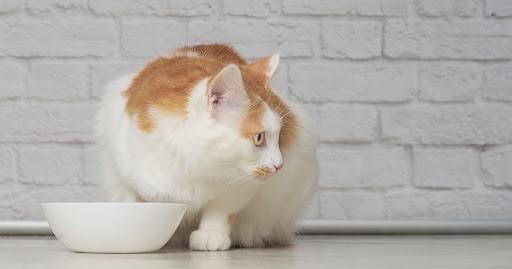
Arthritis is a painful condition for cats, and unfortunately it only becomes worse over time. Other diseases, like obesity, can also worsen the negative effects of arthritis on your cat’s quality of life. However, there are many ways you can help improve your cat’s comfort, including helping them achieve and maintain a healthy weight and body condition.
A Stifling Disease
Arthritis affects the joints of cats, including their elbows, shoulders, stifles (knees) and hips. When joints are healthy, the bones are covered with a layer of smooth cartilage that allows them to glide smoothly over each other when your cat moves. If your cat has arthritis, broken-down cartilage prevents this smooth movement and nerves in the underlying bone can be exposed, causing pain. Arthritis can also cause low-grade inflammation of the whole joint, including the surrounding ligaments and muscles. These joint changes can make it difficult and painful for your cat to move around.
Old Age Isn’t the Cause
Cats don’t develop arthritis just because they’ve reached the senior or geriatric stage of life, although, just like a warranty exclusion clause, some normal “wear and tear” on joints is expected after years of jumping, climbing and hard landings (but always on their feet, right?). There are many causes of arthritis in cats, and development and progression of arthritis is likely to be due to a combination of factors. Some contributing causes include body confirmation (how they’re “built”), abnormal joint development or an old injury. Being overweight or obese is also highly correlated with arthritis.
The Fat Factor
Maintaining a healthy weight and body condition score is important for the well-being of all cats, but it’s particularly important for arthritic cats. Carrying extra weight puts added stress on the joint cartilage and ligaments of obese cats. Fat also secretes hormones and other chemicals that increase inflammation throughout the body and add to the inflammation (and pain) already present from arthritis.
Cats Can Hide Arthritis Symptoms
Cats typically project an “I’m fine” attitude even when they’re not fine. They will generally hide pain and illness symptoms, just as their ancestors did to prevent themselves from looking weak to predators seeking out the easiest meal ticket. This is why you need to be vigilant! Some of the signs that you may see if your cat has arthritis are a reduced range of motion, stiffness and muscle loss.
One of the more obvious arthritis signs is changes in their behavior due to pain or restricted movement. Have they stopped resting in their favorite spot up high? Are they jumping and leaping less? Are they grooming themselves less (because it hurts to reach those spots)? Are they having accidents because they can’t get into the litterbox? Is your normally cuddly cat now a grumpy cat? All of these behavior changes could be signs of arthritis or another health condition, so it’s time to schedule a visit to your veterinarian.
Arthritis Can Be Managed
Unfortunately, there is currently no cure for arthritis. However, your veterinarian can provide options for managing your cat’s pain, slowing disease progression and improving your cat’s quality of life. You can help make home more comfortable for them by providing stairs or ramps up to high places, using low-side cat boxes on every floor of the house and helping them with grooming.
If your cat is overweight or obese, starting a veterinarian-supervised weight loss program will likely be part of their arthritis management plan. Losing weight can help reduce the stress placed on your cat’s joints and also reduce the number of fat cells producing inflammation-causing hormones and chemicals.
Your veterinarian may suggest switching to a specialized weight management diet like Diamond CARE Weight Management Formula for Adult Cats. You can also help manage your cat’s weight by avoiding feeding them table scraps and limiting the amount of treats to no more than 10 percent of their daily calories. It’s important that you consult your veterinarian before starting your cat on a diet — if they lose weight too quickly they can develop fatty liver disease (also called hepatic lipidosis) which can be life threatening.
Obesity and arthritis can both limit your cat’s movement abilities and negatively affect their quality of life. If you think your cat has arthritis or could benefit from losing a few pounds, your veterinarian can help develop an appropriate management program for them.
RELATED POST: Fat Cats Face Serious Health Risks

